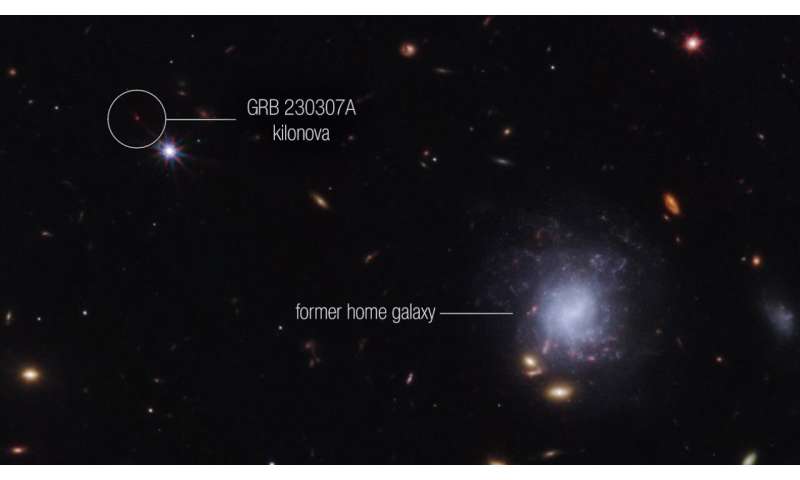Astronomers help to confirm heaviest elements in the Universe are formed in kilonovae

Astrophysicists are one step closer to understanding how the heaviest chemical elements are created in the universe, thanks to a camera designed and built at the University of Sheffield.
Scientists observed the merger of two neutron stars, resulting in an explosion known as a kilonova. These events are rare, fast and faint, making them very difficult to find—only one other confirmed kilonova has been observed before.
Studying kilonovae is important because the neutron-rich environments of their explosions are believed to be where the heaviest elements found in nature, such as gold, platinum and uranium, are formed.
Published in Nature, scientists including those at the University of Sheffield observed the tell-tale red light from the kilonova, due to the absorption of blue light by the heavy elements produced in the explosion. The presence of heavy elements was confirmed by observations with the James Webb Space Telescope (JWST), which discovered tellurium in the infrared spectrum of the kilonova. Tellurium is next to iodine in the periodic table, implying significant quantities of iodine—essential for life on Earth—were also formed in the explosion.
The first optical images of the kilonova were obtained with the University of Sheffield's ULTRACAM instrument at the 3.5m New Technology Telescope of the European Southern Observatory in Chile.
Professor Vik Dhillon, from the University of Sheffield's Department of Physics and Astronomy who leads the ULTRACAM project, said: "Our camera ULTRACAM was the first instrument to pinpoint the location of the gamma-ray burst, the second brightest one ever observed, that indicated the start of the kilonova explosion. Our discovery then allowed us to trigger other telescopes around the world for follow-up observations, including the JWST.
"This is only the second secure kilonova that has been found. Kilonovae are particularly important because it is where most of the heaviest elements in the periodic table are believed to be produced, including gold and platinum and uranium, for example. This means we are now one step closer to understanding how the heaviest chemical elements are created in the universe."
Dr Stuart Littlefair, from the University of Sheffield's Department of Physics and Astronomy who was involved in the research, said: "The role ULTRACAM played was one of being in the right place at the right time.
"These objects fade away very quickly and it takes a sensitive camera mounted on a large telescope to detect the optical light from the merging compact objects.
"ULTRACAM was able to find the faint optical counterpart and allow follow up with other telescopes. In addition, ULTRACAM can take pictures in several wavelengths of light at once, and the colour was one of the first hints that this event was something special."
More information:
Andrew Levan et al, Heavy element production in a compact object merger observed by JWST, Nature (2023). DOI: 10.1038/s41586-023-06759-1
Provided by University of Sheffield